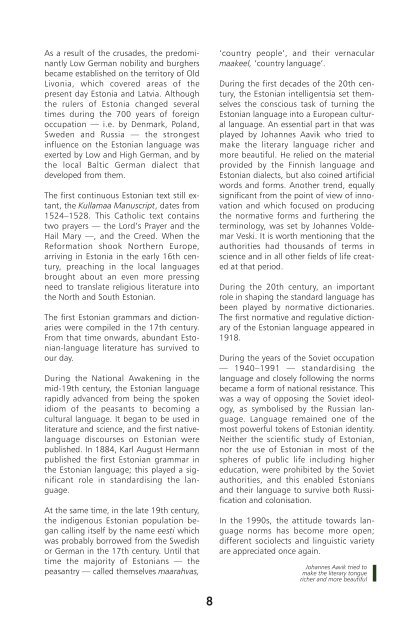You also want an ePaper? Increase the reach of your titles
YUMPU automatically turns print PDFs into web optimized ePapers that Google loves.
As a result of the crusades, the predominantly<br />
Low German nobility and burghers<br />
became established on the territory of Old<br />
Livonia, which covered areas of the<br />
present day Estonia and Latvia. Although<br />
the rulers of Estonia changed several<br />
times during the 700 years of foreign<br />
occupation — i.e. by Denmark, Poland,<br />
Sweden and Russia — the strongest<br />
influence on the Estonian language was<br />
exerted by Low and High German, and by<br />
the local Baltic German dialect that<br />
developed from them.<br />
The first continuous Estonian text still extant,<br />
the Kullamaa Manuscript, dates from<br />
1524–1528. This Catholic text contains<br />
two prayers — the Lord’s Prayer and the<br />
Hail Mary —, and the Creed. When the<br />
Reformation shook Northern Europe,<br />
arriving in Estonia in the early 16th century,<br />
preaching in the local languages<br />
brought about an even more pressing<br />
need to translate religious literature into<br />
the North and South Estonian.<br />
The first Estonian grammars and dictionaries<br />
were compiled in the 17th century.<br />
From that time onwards, abundant Estonian-language<br />
literature has survived to<br />
our day.<br />
During the National Awakening in the<br />
mid-19th century, the Estonian language<br />
rapidly advanced from being the spoken<br />
idiom of the peasants to becoming a<br />
cultural language. It began to be used in<br />
literature and science, and the first nativelanguage<br />
discourses on Estonian were<br />
published. In 1884, Karl August Hermann<br />
published the first Estonian grammar in<br />
the Estonian language; this played a significant<br />
role in standardising the language.<br />
At the same time, in the late 19th century,<br />
the indigenous Estonian population began<br />
calling itself by the name eesti which<br />
was probably borrowed from the Swedish<br />
or German in the 17th century. Until that<br />
time the majority of Estonians — the<br />
peasantry — called themselves maarahvas,<br />
‘country people’, and their vernacular<br />
maakeel, ‘country language’.<br />
During the first decades of the 20th century,<br />
the Estonian intelligentsia set themselves<br />
the conscious task of turning the<br />
Estonian language into a European cultural<br />
language. An essential part in that was<br />
played by Johannes Aavik who tried to<br />
make the literary language richer and<br />
more beautiful. He relied on the material<br />
provided by the Finnish language and<br />
Estonian dialects, but also coined artificial<br />
words and forms. Another trend, equally<br />
significant from the point of view of innovation<br />
and which focused on producing<br />
the normative forms and furthering the<br />
terminology, was set by Johannes Voldemar<br />
Veski. It is worth mentioning that the<br />
authorities had thousands of terms in<br />
science and in all other fields of life created<br />
at that period.<br />
During the 20th century, an important<br />
role in shaping the standard language has<br />
been played by normative dictionaries.<br />
The first normative and regulative dictionary<br />
of the Estonian language appeared in<br />
1918.<br />
During the years of the Soviet occupation<br />
— 1940–1991 — standardising the<br />
language and closely following the norms<br />
became a form of national resistance. This<br />
was a way of opposing the Soviet ideology,<br />
as symbolised by the Russian language.<br />
Language remained one of the<br />
most powerful tokens of Estonian identity.<br />
Neither the scientific study of Estonian,<br />
nor the use of Estonian in most of the<br />
spheres of public life including higher<br />
education, were prohibited by the Soviet<br />
authorities, and this enabled Estonians<br />
and their language to survive both Russification<br />
and colonisation.<br />
In the 1990s, the attitude towards language<br />
norms has become more open;<br />
different sociolects and linguistic variety<br />
are appreciated once again.<br />
Johannes Aavik tried to<br />
make the literary tongue<br />
richer and more beautiful<br />
8


